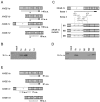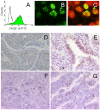Identification of XAGE-1 isoforms: predominant expression of XAGE-1b in testis and tumors
- PMID: 17335148
- PMCID: PMC2935747
Identification of XAGE-1 isoforms: predominant expression of XAGE-1b in testis and tumors
Abstract
XAGE-1 is a cancer/testis (CT) antigen and has been shown to be immunogenic in lung cancer patients. Among 4 alternative splicing variants, XAGE-1a, b, c and d, XAGE-1b mRNA was dominantly expressed in cancer. In this study, we generated a XAGE-1b mAb, USO9-13. The B cell epitope recognized by the USO9-13 mAb was in the C-terminal region of the XAGE-1b protein and is also recognized by sera from patients with lung adenocarcinoma. Using USO9-13 and an anti-Flag mAb, we examined the translation products of the 4 transcripts. The XAGE-1a and b transcripts translated to the XAGE-1b protein. The XAGE-1c transcript possibly translated to 9- and 17-aa polypeptides. The XAGE-1d transcript translated to a protein consisting of 69 amino acids. Immunofluorescence analysis using USO9-13 mAb showed that the XAGE-1b protein is located in the nuclei of cells. Immunohistochemically, nuclear staining was heterogeneously observed in 25/47 lung adenocarcinomas, 1/12 hepatocellular carcinomas and 1/11 gastric cancers, but not in adjacent normal tissues. These findings suggested that XAGE-1b is a promising target molecule for a cancer vaccine against lung cancer.
Figures
Similar articles
-
Prolonged survival of patients with lung adenocarcinoma expressing XAGE-1b and HLA class I antigens.Cancer Immun. 2008 Aug 28;8:13. Cancer Immun. 2008. PMID: 18752338 Free PMC article.
-
Immunoscreening of a cDNA library from a lung cancer cell line using autologous patient serum: Identification of XAGE-1b as a dominant antigen and its immunogenicity in lung adenocarcinoma.Int J Cancer. 2004 Feb 10;108(4):558-63. doi: 10.1002/ijc.11587. Int J Cancer. 2004. PMID: 14696120
-
XAGE-1 expression in non-small cell lung cancer and antibody response in patients.Clin Cancer Res. 2005 Aug 1;11(15):5496-503. doi: 10.1158/1078-0432.CCR-05-0216. Clin Cancer Res. 2005. PMID: 16061866
-
A dendritic cell-based tumour vaccine for lung cancer: full-length XAGE-1b protein-pulsed dendritic cells induce specific cytotoxic T lymphocytes in vitro.Clin Exp Immunol. 2008 Sep;153(3):392-400. doi: 10.1111/j.1365-2249.2008.03724.x. Clin Exp Immunol. 2008. PMID: 18803763 Free PMC article.
-
Spontaneous antibody, and CD4 and CD8 T-cell responses against XAGE-1b (GAGED2a) in non-small cell lung cancer patients.Int J Cancer. 2012 Sep 1;131(5):E649-58. doi: 10.1002/ijc.27359. Epub 2012 Jan 3. Int J Cancer. 2012. PMID: 22109656
Cited by
-
Cancer testis antigen XAGE-1 is a promising marker for the diagnosis and treatment of ovarian cancer.J Med Life. 2021 Sep-Oct;14(5):710-715. doi: 10.25122/jml-2021-0304. J Med Life. 2021. PMID: 35027975 Free PMC article.
-
The role of alternative splicing in lung cancer.Cancer Chemother Pharmacol. 2023 Aug;92(2):83-95. doi: 10.1007/s00280-023-04553-4. Epub 2023 Jun 19. Cancer Chemother Pharmacol. 2023. PMID: 37335335 Review.
-
A robust tool for discriminative analysis and feature selection in paired samples impacts the identification of the genes essential for reprogramming lung tissue to adenocarcinoma.BMC Genomics. 2011 Nov 30;12 Suppl 3(Suppl 3):S24. doi: 10.1186/1471-2164-12-S3-S24. Epub 2011 Nov 30. BMC Genomics. 2011. PMID: 22369099 Free PMC article.
-
Engineering Cancer/Testis Antigens With Reversible S-Cationization to Evaluate Antigen Spreading.Front Oncol. 2022 May 4;12:869393. doi: 10.3389/fonc.2022.869393. eCollection 2022. Front Oncol. 2022. PMID: 35600379 Free PMC article.
-
Prolonged survival of patients with lung adenocarcinoma expressing XAGE-1b and HLA class I antigens.Cancer Immun. 2008 Aug 28;8:13. Cancer Immun. 2008. PMID: 18752338 Free PMC article.
References
-
- Scanlan MJ, Simpson AJ, Old LJ. The cancer/testis genes: review, standardization, and commentary. Cancer Immun. 2004;4:1. http://www.cancerimmunity.org/v4p1/031220.htm - PubMed
-
- Jager E, Chen YT, Drijfhout JW, Karbach J, Ringhoffer M, Jager D, Arand M, Wada H, Noguchi Y, Stockert E, Old LJ, Knuth A. Simultaneous humoral and cellular immune response against cancer-testis antigen NY-ESO-1: definition of human histocompatibility leukocyte antigen (HLA)-A2-binding peptide epitopes. J Exp Med. 1998;187:265–270. - PMC - PubMed
-
- Ayyoub M, Stevanovic S, Sahin U, Guillaume P, Servis C, Rimoldi D, Valmori D, Romero P, Cerottini JC, Rammensee HG, Pfreundschuh M, Speiser D, Levy F. Proteasome-assisted identification of a SSX-2-derived epitope recognized by tumor-reactive CTL infiltrating metastatic melanoma. J Immunol. 2002;168:1717–1722. - PubMed
-
- Juretic A, Spagnoli GC, Schultz-Thater E, Sarcevic B. Cancer/testis tumour-associated antigens: immunohistochemical detection with monoclonal antibodies. Lancet Oncol. 2003;4:104–109. - PubMed
-
- Brinkmann U, Vasmatzis G, Lee B, Pastan I. Novel genes in the PAGE and GAGE family of tumor antigens found by homology walking in the dbEST database. Cancer Res. 1999;59:1445–1448. - PubMed
Publication types
MeSH terms
Substances
LinkOut - more resources
Full Text Sources
Other Literature Sources
Molecular Biology Databases





